China Weather – China Climate & Seasonal Travel Guide
China’s weather is characterized by a distinct continental monsoon climate, with cold winters and hot summers. However, due to its vast land, defining China’s weather in a few words is challenging. The country boasts a diverse climate, with weather varying from region to region based on different temperature zones and landforms. This diversity means that two cities in China can have completely different climates at the same time, making it an ideal destination for year-round travel.
No matter when you visit China, you will find incredible places to explore. Each season offers a unique experience, with varying scenery to enjoy. It is essential to pack and dress appropriately for the different climates you may encounter in various regions or months.
Our China Weather Guide provides information on today’s weather, climatic characteristics, the different climates of top tourist cities, features of the four seasons, and top recommended tours by month. This guide will help you make the most of your China tour and ensure you have a memorable experience.
China Climate Types
The temperature fluctuates significantly across cities situated in various climate zones. China boasts five distinct climate types, each with its own unique characteristics. These include the Tropical Monsoon Climate, Subtropical Monsoon Climate (found in cities such as Shanghai, Guilin, Zhangjiajie, Kunming, and Hangzhou), Temperature Monsoon Climate (observed in Beijing, Xian, Luoyang, and Pingyao), Temperate Continental Climate (experienced in Harbin and Inner Mongolia), and Alpine Cold Climate (seen in Chengdu, Lhasa, Jiuzhaigou, and Qinghai). Each climate type offers a different experience, making China a diverse and fascinating destination for travelers seeking a variety of climates and landscapes.
Precipitation and Humidity
The amount of precipitation decreases as you move from the southeast to the northwest. Coastal cities in the southeast typically receive around 2,000 mm of rainfall annually. In the farther northern areas along the Huai River, the annual rainfall decreases to approximately 880 mm. The northeastern regions along the Yellow River receive around 600 mm of rainfall each year. The rainy season typically occurs from June to August, resulting in higher humidity levels in the summer and lower levels in the winter.
Monsoon and Typhoon
Typhoons typically move in a westward or northern direction, frequently making landfall in China more often than in other Asian countries. The monsoon season in China typically occurs from May to September, following a route from the southeast coast, through the middle and lower reaches of the Yangtze River, and into northern and northeastern China. The most destructive typhoons tend to hit the southern and eastern coastal regions of China, particularly in provinces such as Fujian, Hainan, Guangdong, and Zhejiang.
Air Pollution and Smoggy Weather
In recent years, air pollution has become a major concern for travelers. However, due to the government’s efforts to control pollutant discharge, the air quality has significantly improved. Smoggy weather is a common occurrence between November and January in certain northern cities such as Shijiazhuang and Xianyang. It is advisable for visitors to these cities to wear masks to protect themselves from the pollution.
For those seeking tourist destinations with less pollution, Shanghai, Guilin, Hangzhou, Xiamen, Sanya, and Lhasa are recommended options. These cities offer cleaner air and a more enjoyable travel experience.
China Weather in Different Regions
In recent years, air pollution has become a major concern for travelers. However, due to the government’s efforts to control pollutant discharge, the air quality has significantly improved. Smoggy weather is a common occurrence between November and January in certain northern cities such as Shijiazhuang and Xianyang. It is advisable for visitors to these cities to wear masks to protect themselves from the pollution.
For those seeking tourist destinations with less pollution, Shanghai, Guilin, Hangzhou, Xiamen, Sanya, and Lhasa are recommended options. These cities offer cleaner air and a more enjoyable travel experience.
| Area | Cities (Provinces/Municipalities) |
Weather & Climate |
|---|---|---|
| Northern China | Beijing, Xian(Shaanxi), Shandong, Luoyang(Henan), Pingyao(Shanxi) and other places | Avg Temperature: -1°C~31°C The northern region has mainly temperate continental climate and temperate monsoon climate. The temperature in winter is lower than 0°C, and the temperature in summer is higher than 20°C. The temperature changes in four seasons. The coldest month occurs in January, and the hottest month is July. There is little precipitation throughout the year, and the seasonal distribution is uneven, with precipitation concentrated in summer. |
| Eastern China | Shanghai, Huangshan(Anhui), Hangzhou(Zhejiang), Suzhou(Jiangsu) and other places | Avg Temperature: 5°C~32°C Most of southeast China belongs to the subtropical monsoon climate zone. The climate is mild and humid throughout the year with abundant rainfall. The seasonal changes in wind are obvious, with alternating cold and summer, and four distinct seasons. Its main climatic characteristics are: rainy spring, sultry summer, cool autumn air, and wet and cold winter. The time from March to May (spring) and the late September to November (autumn) boasts comfortable temperatures and fewer tourists and rain showers, making it the best time to travel. |
| Southern China | Guilin(Guangxi), Zhangjiajie(Hunan) and other places | Avg Temperature: 7°C~33°C Both Guilin and Zhangjiajie have a subtropical monsoon climate, with four distinct seasons. Summer in Guilin and Zhangjiajie is hot and sunny and the rainfall is abundant. It is not too cold in winter and you can visit this region for a comfortable winter holiday. Spring and autumn are also the best time for these cities. |
| Southwestern China | Chengdu (Sichuan), Yunnan, Guizhou and other places | Avg Temperature: -13°C~30°C Most areas of Sichuan, Yunnan and Guizhou provinces belong to the subtropical monsoon climate zone, while the higher altitude areas belong to the alpine plateau climate zone. Sichuan and Chongqing have distinct seasons. In Guizhou and Yunnan, you can enjoy a comfortable weather all year round. |
| Northwestern China | Gansu, Xinjiang, Ningxia and other places | Avg Temperature: -16 °C~30°C The northwestern region is deep inland and far away from the sea. Coupled with the high plateaus and mountainous terrain that block the humid airflow, the area has sparse precipitation and arid climate, forming a landscape of vast deserts and Gobi beaches. Winters are severely cold and dry, summers are hot, and precipitation is scarce, showing a decreasing trend from east to west. |
| Southern Coastal China | Hong Kong, Guangzhou (Guangdong), Shenzhen, Macau, Hainan, Xiamen and other places | Avg Temperature: 11°C~35°C Located on the subtropical coast, with the Tropic of Cancer passing through the central and southern regions, this region has a maritime subtropical monsoon climate characterized by warm and rainy, abundant light and heat, long summers and short frost periods. The cities in this region have a very small annual average temperature difference. |
| Northeastern China | Harbin (Heilongjiang), Jilin, Shenyang (Liaoning) and other places | Avg Temperature: -20°C~30°C The northeast is located in a temperate monsoon climate zone. The winter is controlled by temperate continental air masses, which are cold and dry, and the temperature difference between north and south is large; summer is affected by temperate ocean air masses or degeneration of tropical ocean air masses, warm, hot and rainy, and the temperature difference between north and south is small. In addition, the four seasons are distinct and the weather varies significantly. |
| Qinghai-Tibet Plateau | Qinghai, Tibet | Avg Temperature: -15°C~33°C The general characteristics of the climate of the Qinghai-Tibet Plateau: strong radiation, more sunshine, low temperature, less accumulated temperature, temperature decreases with the increase of altitude and latitude, and the temperature difference between the days is large; the dryness and the wetness are distinct, and the night rains; the winter is long and dry and cold, and there are many strong winds; Summer is cool and rainy, with much hail. |
| Inner-Mongolia | Inner Mongolia | Avg Temperature: -14°C~20°C Inner Mongolia has a typical mid-temperate monsoon climate, which is characterized by low and uneven precipitation and drastic changes in cold and heat. The winter is long and cold, and the cold season in most areas lasts from 5 months to half a year. |
China Weather and Best Places to Visit by Season
China’s weather varies significantly with the changing seasons. In spring (March to May), temperatures are warm and the air is dry. Summer (June to August) brings hot and rainy weather. Autumn (September to November) is characterized by cool temperatures and windy days. Winter (December to February) is bitterly cold and freezing in northern China. For a more detailed breakdown of the weather in each season, please see below:
- Spring – March, April & May
In China, spring is traditionally seen as the start of a new year. Serving as the bridge between winter and summer, this season brings about a shift in temperatures from cold to warm, along with adjustments in atmospheric circulation. Northern China tends to have dry air, while southern China experiences higher humidity levels. April and May are particularly ideal months for traveling throughout China during this vibrant and dynamic season.
- Summer – June, July & August
Summer in China lasts from June to August, bringing hot and humid weather to the region. During July, many areas experience temperatures exceeding 30°C, with the highest precipitation levels of 40-70% occurring during this season. Despite the intense heat, there are numerous destinations to visit to escape the summer swelter and enjoy the breathtaking scenery. From tranquil rivers and picturesque lakes to vast grasslands and stunning islandscapes, China offers a diverse range of options for summer travelers seeking relief from the heat.
- Autumn – September, October & November
Autumn in China is a fantastic time to embark on a trip, second only to the beauty of spring. The weather during autumn, particularly in September and October, is incredibly pleasant. The temperature begins to drop, but it remains comfortably warm. With plenty of sunshine and minimal rainfall, you can revel in the sight of floating clouds, clear skies, and the stunning array of autumn colors. For those who enjoy outdoor activities, autumn is undoubtedly the ideal season to explore all that China has to offer.
- Winter – December, January & March
Winter in China, lasting from December to February, is characterized by cold temperatures, dry air, and minimal precipitation. The decrease in temperature from south to north is a result of the winter monsoon. As the days grow shorter and the nights longer, travelers can enjoy the picturesque snow-covered landscapes and thrilling winter sports that the cold weather brings.
Top 6 Frequently-asked Questions About China Weather?
1. When is the Best Time to Visit China?
In China, a country known for its diversity, finding the perfect destination for each month is a breeze. There are countless places that boast cultural charm and stunning city views, making them ideal for year-round visits. Destinations such as Beijing, Xian, Shanghai, Guangzhou, Nanjing, and Luoyang offer a wealth of experiences for travelers.
For those seeking the most comfortable weather with mild temperatures and minimal rainfall, spring and autumn are the optimal seasons to visit. Specifically, the months of April, May, September, and October offer the best conditions for exploring all that China has to offer.
2. When is the Golden Week of China and How to Avoid Crowds during the Golden Week?
China Golden Week typically refers to the Chinese National Holiday, a week-long holiday that runs from October 1st to 7th, sometimes extending to 8 days due to the mid-autumn Festival coinciding with the Golden Week. This period is known as the busiest travel time in China, with popular tourist destinations becoming overcrowded. The costs of meals, accommodation, and transportation tend to rise, and tickets sell out rapidly.
It is highly recommended to avoid traveling to China during the Golden Week if possible. However, if you must travel during this time, it is essential to book your hotel and transportation tickets well in advance. Additionally, consider visiting less crowded destinations such as the Silk Road, Tibet, Inner Mongolia, Xinjiang, among others. These locations offer a unique and less hectic travel experience during this busy holiday period.
3. Which Kind of Extreme Weather Occurs in China?
Typhoons are most commonly experienced during the summer months of July, August, and September along the coastlines of southern China, including regions such as Guangdong, Taiwan, Hainan, and Fujian.
Sandstorms, on the other hand, are not as frequent in China and typically occur in late winter (March) and early spring (February). The northern regions of China, such as the southern Xinjiang basin, southwestern Qinghai, western Tibet, central and western Inner Mongolia, and central and northern Gansu, are the areas most affected by sandstorms.
Floods are a common occurrence in southern and southeastern China, particularly in regions like Guangdong, Guangxi, Zhejiang, and Jiangsu, due to the heavy rainfall in July and August. Torrential floods also impact areas such as Anhui, Liaoning, Hunan, Guizhou, and Yunnan.
4. How to Enjoy a Winter Holiday in China?
Do not let the cold weather of winter intimidate you, as there is plenty of fun to be had if you choose to travel during this season. The breathtaking snow views and exciting snow activities are the main attractions of a winter holiday. For those seeking a picturesque snowscape journey, destinations such as Jiuzhaigou, Yellow Mountain, Mount Emei, Xiling Snow Mountain, and Jilin are highly recommended. If you are looking for snow sports fun, consider visiting Harbin, Jilin, Beijing, Zhangjiakou, and Emeishan.
Additionally, there are warm destinations to explore during the winter months, such as Yunnan (Kunming, Dali, Lijiang), Fujian (Xiamen, Tulou), Hainan Island (Sanya, Haikou), the Great Bay Area (Hong Kong, Macao, Shenzhen, Guangzhou), and Guangxi (Guilin, Yangshuo, Longsheng). These locations offer a perfect escape from the cold and provide a different kind of winter experience.
5. Where to Escape Summer Heat in China?
Just like winter, summer may not be suitable for all destinations, but there are still plenty of amazing options for a great summer holiday. From the eye-pleasing green grasslands of Hohhot to the green and blue fairyland of Jiuzhaigou, the everlasting spring weather of Yunnan, the breathtaking Avatar scenery of Zhangjaijie, and the amazing bamboo shelter of Moganshan, there are countless cool destinations to explore during the summer months.
6. Where to Appreciate Seasonal Flowers in China?
China boasts a diverse array of blooming flowers throughout the year, each offering a unique and breathtaking sight. For those who appreciate the golden sea of rapeseed flowers, Wuyuan and Luoping are highly recommended destinations. If you are enchanted by cherry blossoms, Wuhan is the perfect place to visit. Plum blossom enthusiasts will find ancient Nanjing a treasure trove waiting to be discovered. In addition to these, China also offers pear blossoms, peach blossoms, peony flowers, and many more floral wonders waiting to be explored.




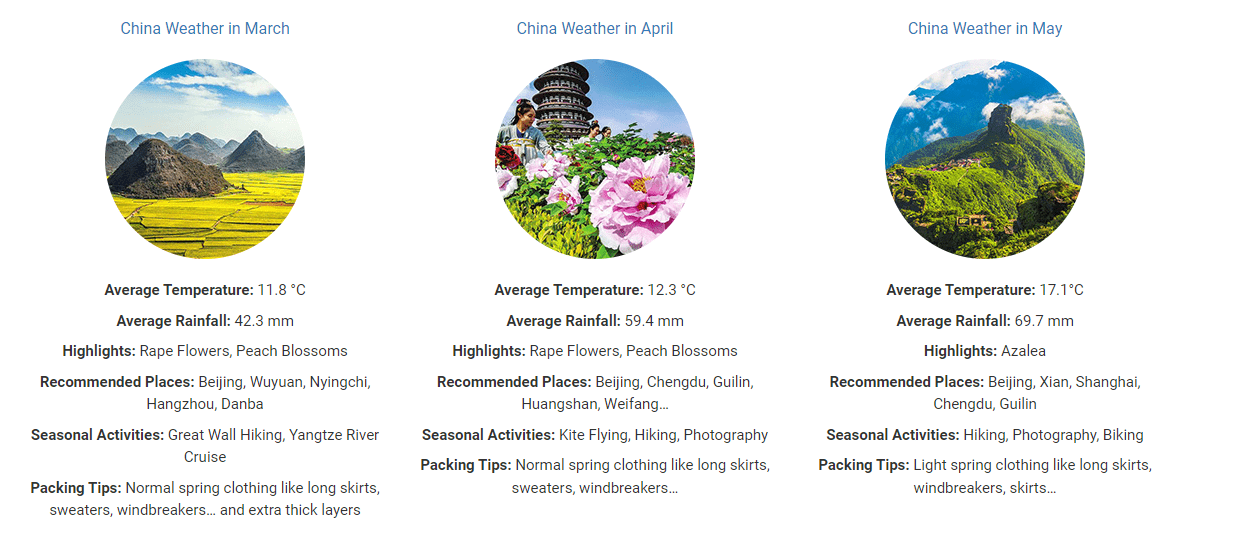
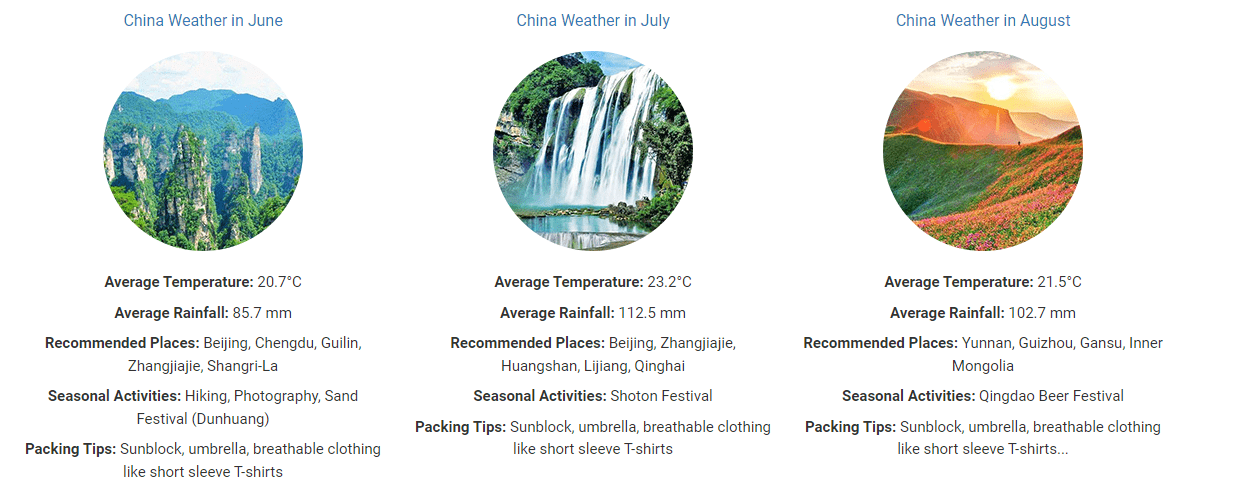
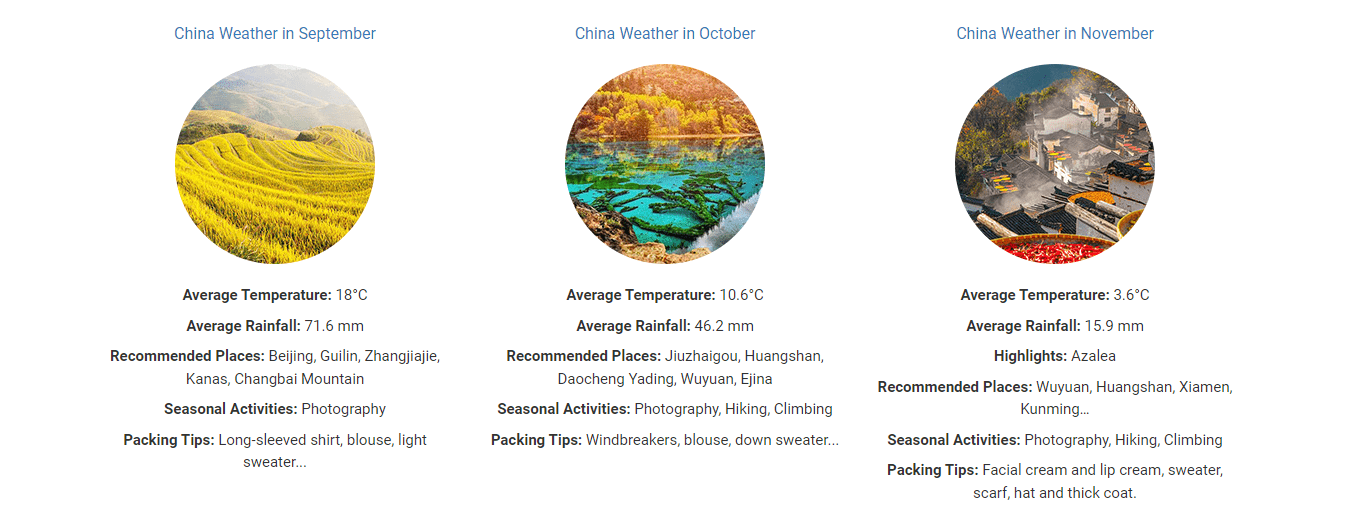
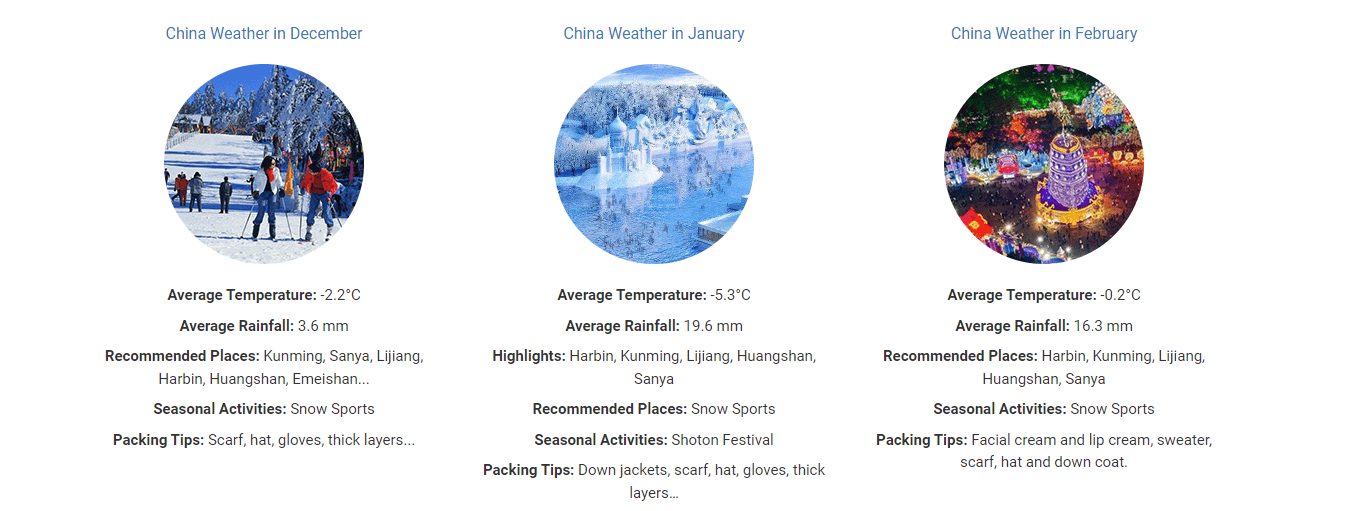








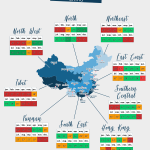




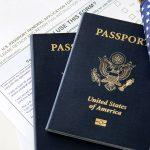




 Online | Privacy policy
Online | Privacy policy